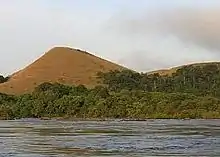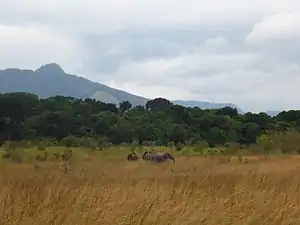Lopé National Park
Lopé National Park is a national park in central Gabon. Although the terrain is mostly monsoon forest, in the north the park contains the last remnants of grass savannas created in Central Africa during the last Ice Age, 15,000 years ago. It was the first protected area in Gabon when the Lopé-Okanda Wildlife Reserve was created in 1946. In 2007, the Lopé-Okanda landscape was added to the World Heritage List by UNESCO.
| Lopé National Park | |
|---|---|
IUCN category II (national park) | |
 Panorama of the northern savanna-dominated part Lopé National Park, shortly after the annual burning of the grasses | |
| Location | Gabon |
| Coordinates | 0°30′00″S 11°30′00″E |
| Area | 4,910 km2 (1,900 sq mi) |
| Established | 2002 |
| Governing body | National Agency for National Parks |
| Official name | Ecosystem and Relict Cultural Landscape of Lopé-Okanda |
| Type | Mixed |
| Criteria | iii, iv, ix, x |
| Designated | 2007 (31st session) |
| Reference no. | 1147 |
| State Party | Gabon |
| Region | Africa |



The park contains a small research station, named as Mikongo and run by the Zoological Society London, based in the village known as Mikongo, from which it gets its name. There exists infrastructure to cater for tourists at the base, including several chalets and a large open air dining room, from which the rainforest is a mere five meters away.[1] The park also hosts CEDAMM Training Centre, a Wildlife Conservation Society-run international conservation education center.
References
- "AP via Washington Post "UNESCO Committee Renames Auschwitz" 28 June 2007". Archived from the original on 2 November 2012. Retrieved 26 October 2017.